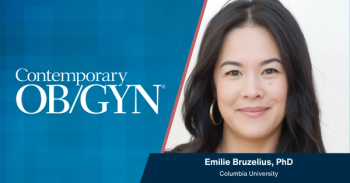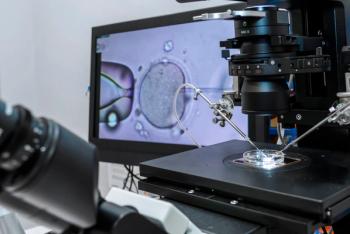
Post-Tubal Ligation Pain
OBGYN.net Conference CoverageFrom IPPS - Simsbury Connecticut - April/May, 1999
Dr. Carter: "I'm Dr. James Carter from Mission Viejo, and I'm here in Connecticut at the International Pelvic Pain Society meeting interviewing Ahmed El-Minawi, MD, Ph.D. who is a visiting Assistant Professor at the University of Rochester and will be a senior lecturer in obstetrics and gynecology in Cairo, Egypt. Also, I'm very pleased to announce he is co-author with Dr. Fred Howard, Dr. Paul Perry, and myself of a text - Care of the Woman with Chronic Pelvic Pain. Ahmed, you've written a large number of chapters for this book, and one area in specific that you have a great deal to do with is this problem of what you call "post tubal ligation pain." Do you want to describe that to us?"
Dr. El-Minawi:: "Yes, when I first came to work for Dr. Howard, a lot of interest was in the pelvic congestion syndrome. Pelvic congestion syndrome is a very big notion to many people but it was a notion of interest to me, particularly since Cairo University. A lot of work was done over the past 20 years on the issue of post-tubal ligation syndrome, which over the world was not really considered to be a major issue except in Britain, or the United States. Particularly in the past ten years, post-tubal ligation syndrome was really not believed in but we've seen a lot of patients who during the 70's and 80's had tubal sterilizations - usually in their mid to late 20's - who presented -usually in their late 30's to early 40's - with symptoms of severe pelvic congestion. Most of the women would present with dull aching pain, the majority of them had deep dysparuenia, and almost all of them had post-coital ache. Post-coital ache, in Professor Richard Beard's opinion, is the most diagnostic sign and the pelvic congestion following post-tubal ligation syndrome. Now an issue is that mostly these patients are in their fourth decade, and that's because they usually have had the tubal ligations at the end of their family producing cycle, usually in their 20's. Most of them present anywhere between five to ten years with an average of seven years following the surgery. Most of them have had tubal ligations with destructive tubal ligation types, Pomeroy-type tubal ligations, Irving-type tubal ligations; basically mid-segments tubal ligations are the worst type and are the most causes of post-tubal ligation syndrome. Mareaski clips and others are less traumatic because they cause less of a disturbance in the utero-ovarian circulation, and therefore, the pelvic congestion is not as severe as seen with other modalities like destructive operations of the mid-tubal segment. In most cases, and we've done blood refuse on most of these patients, there is a severe destruction and large number of vareces. At the same time the Doppler was done, and this also showed us that there was an increasing resistance index of the uterine artery blood flow as compared to normal patients. The series was not that large but I need to follow-up, but definitely - we believe in post-tubal ligation syndrome. Most of the patients present also with menstrual disturbances, usually menorrhagia, menometromenorrhagia, and sorry to say - the majority of the patients ended up as hysterectomy candidates. A lot of different symptomatic-type treatments were followed-up and used with these patients, but the majority ended up as hysterectomy candidates after which the pain was resolved."
Dr. Carter: "Dr. Kurst Semm has spoken extensively and written extensively about the post-tubal ligation syndrome and found very similar results that if these procedures were performed with his form of minimally coagulative using thermal energy at 100 degrees centigrade, that the condition was certainly lessened; backing up significantly what Dr. El-Minawi has said, that destructive techniques using, for instance, bipolar cautery at high energy levels can result. In my experience, Ahmed, I have seen a very similar thing, very similar when you said 5-10 years, on average 7 years. The cases that I have followed, patients who arrived at hysterectomy because of menorrhagia and pain, looking at 80 cases, very high percentage, statistically significant those women with tubal ligation by destructive means - much higher than you would anticipate finding for those symptoms. Now the other interesting fact that I've found was that on pathology, a very high percentage of those women with post-tubal ligation syndrome had adenomyosis. Was that your finding as well or was it a pathological grouping?"
Dr. El-Minawi: "I can tell you we had a series of 978 cases which were presented AAGL a couple of years ago, 80 cases of which were post-tubal ligation syndrome, 60% of those had actual hemographic findings of pelvic congestion, and among those 80 patients there were at least 30-40 patients with additional pathological findings including adenomyosis."
Dr. Carter: "We don't know if the adenomyosis is the cause of the pain or if it's the cause of the bleeding. We don't have that completely sorted out but this finding of relationship with pelvic congestion after tubal ligation, I believe, is a real problem. So if an individual has had a tubal ligation 5-10 years prior, is experiencing more and more heavy bleeding, is experiencing more and more pain, then in fact, they may have this syndrome."
Dr. El-Minawi: "Definitely."
Dr. Carter: "Now, one of the chapters that you wrote, to change the topic a little bit, is on constipation, and that is in fact, a cause of chronic pelvic pain. Could you describe how that is a factor?"
Dr. El-Minawi: "Basically in women with chronic pelvic pain, first of all, constipation is a major equalizer; it occurs in all races and all ages, crosses oceans. So basically, constipation has what I call "multi-factorial etiology." It's very, very difficult to reach a diagnosis, particularly in women with chronic pelvic pain who may also have other additional factors, that the constipation may either be the cause of the chronic pelvic pain or secondary to the chronic pelvic pain. In most cases where on it is the cause of the chronic pelvic pain, in the pelvis endometriosis is quite the factor. There have been case reports of endometriosis involving the sigmoid causing strictures, and thereby, causing obstructed type of constipation. In other women there have been other problems, musculoskeletal problems that have basically caused constipation, in particular, anismus. Anismus is a tubal-rectalis dysfunction in which there is failure of relaxation of the muscle, and that will cause an obstructive type of constipation. Women with large rectoceles can also have constipation. Rectocele, in particular, is relatively difficult to diagnosis as a main cause of constipation; assuming that tomography is probably the best technique in verifying whether or not the rectocele is actually the cause of the constipation or is just an incidental finding because almost 75% of patients with rectocele will have incidental constipation. So thereby, doing investigations such as seeing the tomography will definitely show us whether or not this is true. As regards to anismus, doing anal EMG will be very effective in the following - whether or not the tubal-rectalis is contraction syndrome and is the cause of the constipation. In many cases, a patient course has been written on the use of surgery in the treatment of tubal-rectalis contraction syndrome. The problem of that is there has been severe mobility associated with that, so in these cases, the best form of therapy at present is biofeedback. Biofeedback is done using a variety of different techniques, the best of which is an anal probe EMG-type biofeedback, and that has produced results up to 80-90% in the hands of investigators who are top gun on this issue."
Dr. Carter: "In concurrence with what you've heard, I have found in my practice, biofeedback techniques are helpful not only for the anal muscle sphincter spasm and relaxation, but in addition, for what is frequently called "levator ani syndrome" or "pubic muscle contraction syndrome." These biofeedback techniques are very helpful in allowing patients to gain control of these muscles and reduce their pain level. In addition, these types of symptoms - levator ani spasm, spasm of the rectal muscles, spasms of the muscles of the pelvic floor which are usually identifiable as trigger points, can respond to a combination of trigger point injection therapy, biofeedback, and physical therapy. I know at the University of Rochester with Dr. Howard, you've been involved in setting up programs for exactly this type of therapy, and they've been very, very successful. However, we have to remember that the constipation can, as you pointed out, come from a stricture-type cause, and one has to be concerned any time there are changes in bowel function in a patient - even just as young as thirty - that we look for, evaluate, and insure that this is a functional and not a, for instance, cancer or obstructive problem - such as endometriosis. Once those are eliminated, dietary changes probably back the type of program that you've started."
Dr. El-Minawi: "And speaking of endometriosis, one of the things is that laparoscopy, even though it has not typically been used in constipation, is actually a very good tool for the diagnosis of symptomatology such as endometriosis in cases with severe constipation of unknown etiology."
Dr. Carter: "We have been most fortunate to have Dr. El-Minawi here in Connecticut, participating in the Pelvic Pain Society meeting, and also to have him contribute a tremendous amount of work to the upcoming book that Dr. Fred Howard is editing, Care of the Women with Chronic Pelvic Pain. Thank you very much."
Dr. El-Minawi: "Thank you sir."
Newsletter
Get the latest clinical updates, case studies, and expert commentary in obstetric and gynecologic care. Sign up now to stay informed.
















